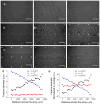"Force-feedback" leveling of massively parallel arrays in polymer pen lithography
- PMID: 20184292
- PMCID: PMC4608019
- DOI: 10.1021/nl904200t
"Force-feedback" leveling of massively parallel arrays in polymer pen lithography
Abstract
Polymer pen lithography is a recently developed molecular printing technique which can produce features with diameters ranging from 80 nm to >10 microm in a single writing step using massively parallel (>10(7) pens) arrays of pyramidal, elastomeric pens. Leveling these pen arrays with respect to the surface to produce uniform features over large areas remains a considerable challenge. Here, we describe a new method for leveling the pen arrays that utilizes the force between the pen arrays and the surface to achieve leveling with a tilt of less than 0.004 degrees, thereby producing features that vary by only 50 nm over 1 cm.
Figures





Similar articles
-
Large-area molecular patterning with polymer pen lithography.Nat Protoc. 2013 Dec;8(12):2548-60. doi: 10.1038/nprot.2013.159. Epub 2013 Nov 21. Nat Protoc. 2013. PMID: 24263094 Free PMC article.
-
Hard Transparent Arrays for Polymer Pen Lithography.ACS Nano. 2016 Mar 22;10(3):3144-8. doi: 10.1021/acsnano.6b00528. Epub 2016 Mar 1. ACS Nano. 2016. PMID: 26928012 Free PMC article.
-
Apertureless cantilever-free pen arrays for scanning photochemical printing.Small. 2015 Feb 25;11(8):913-8. doi: 10.1002/smll.201402195. Epub 2014 Oct 14. Small. 2015. PMID: 25315252
-
Molecular printing.Nat Chem. 2009 Aug;1(5):353-8. doi: 10.1038/nchem.258. Epub 2009 Jun 28. Nat Chem. 2009. PMID: 21378889 Free PMC article. Review.
-
Patterned polymer brushes.Chem Soc Rev. 2012 Apr 21;41(8):3280-96. doi: 10.1039/c2cs15225h. Epub 2012 Jan 10. Chem Soc Rev. 2012. PMID: 22234473 Review.
Cited by
-
Parallel Microdispensing Method of High-Viscous Liquid Based on Electrostatic Force.Micromachines (Basel). 2022 Mar 30;13(4):545. doi: 10.3390/mi13040545. Micromachines (Basel). 2022. PMID: 35457850 Free PMC article.
-
Large-area molecular patterning with polymer pen lithography.Nat Protoc. 2013 Dec;8(12):2548-60. doi: 10.1038/nprot.2013.159. Epub 2013 Nov 21. Nat Protoc. 2013. PMID: 24263094 Free PMC article.
-
Hard-tip, soft-spring lithography.Nature. 2011 Jan 27;469(7331):516-20. doi: 10.1038/nature09697. Nature. 2011. PMID: 21270890
-
Binary-state scanning probe microscopy for parallel imaging.Nat Commun. 2022 Mar 17;13(1):1438. doi: 10.1038/s41467-022-29181-z. Nat Commun. 2022. PMID: 35301324 Free PMC article.
-
Hard Transparent Arrays for Polymer Pen Lithography.ACS Nano. 2016 Mar 22;10(3):3144-8. doi: 10.1021/acsnano.6b00528. Epub 2016 Mar 1. ACS Nano. 2016. PMID: 26928012 Free PMC article.
References
-
- Kumar A, Whitesides GM. Appl Phys Lett. 1993;6:2002–2004.3.
-
- Xia YN, Rogers JA, Paul KE, Whitesides GM. Chem Rev. 1999;9:1823–1848.9. - PubMed
-
- Xia YN, Whitesides GM. Adv Mater. 1995;7:471–473.
Publication types
MeSH terms
Substances
Grants and funding
LinkOut - more resources
Full Text Sources
Other Literature Sources

